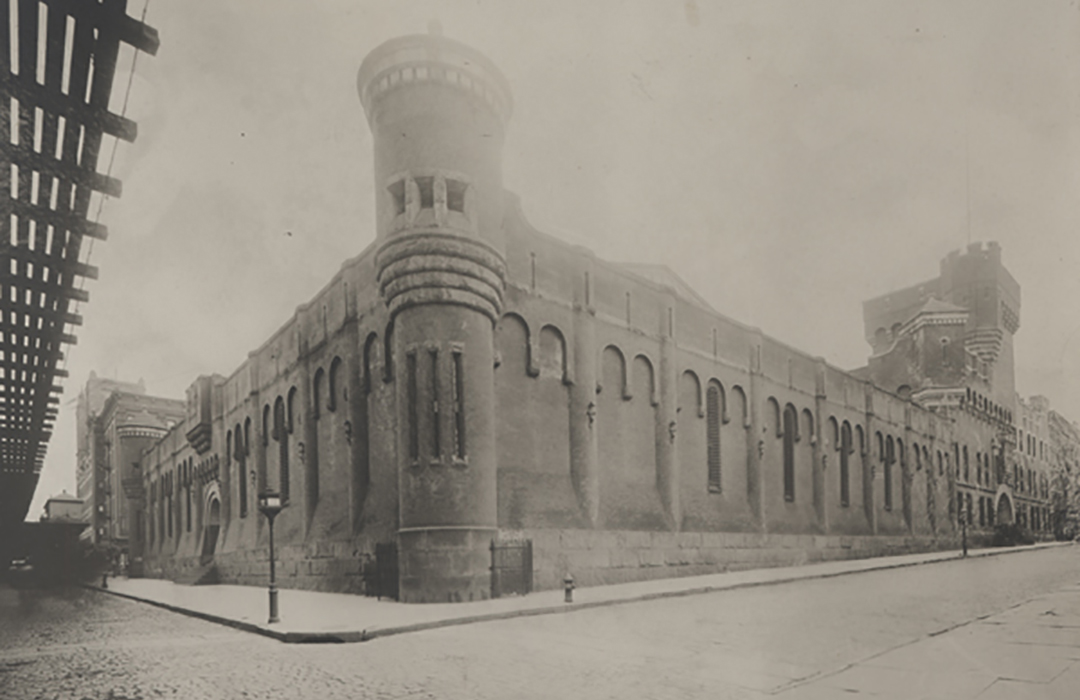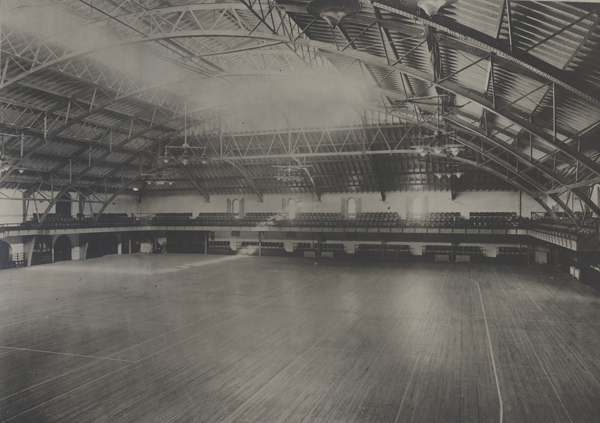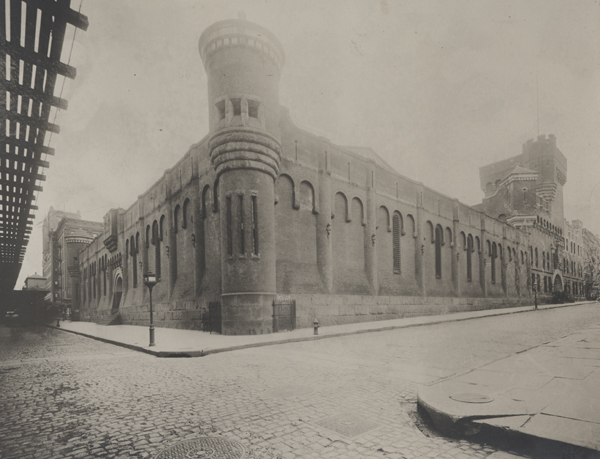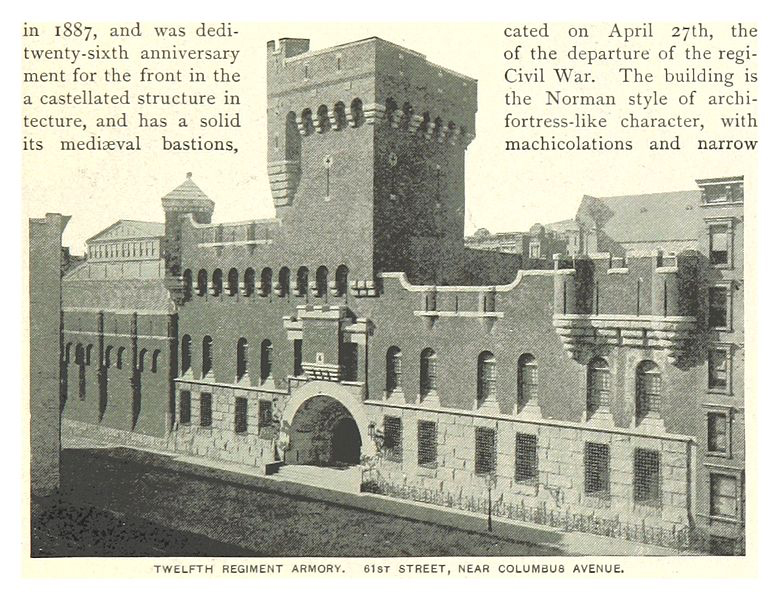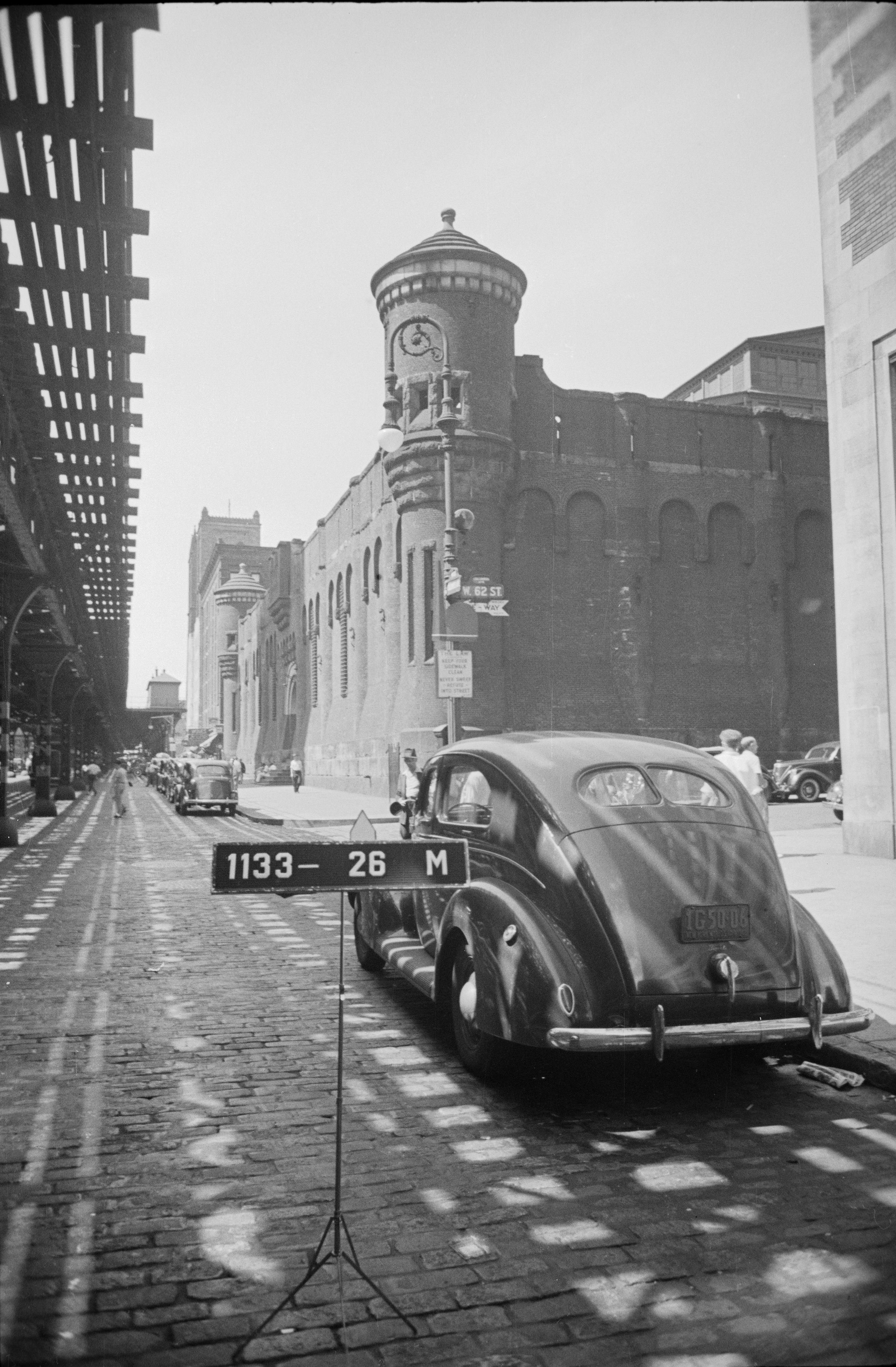
The 212th Coast Artillery Armory
by Katherine Taylor-Hasty
The Lincoln Center was the brainchild of urban renewal and, like many products of that era, owes its location to the systematic destruction of individual buildings, streets, and neighborhoods. One of the buildings cleared was the 212th Coast Artillery Armory, the home base of a coast artillery regiment in the New York Army National Guard, once located on Columbus Avenue, between West 61st and West 62nd streets.
This particular armory was designed by James Ware in 1886-1887.[1] James Edward Ware (1846-1918) was an American architect and was best known for designing the H-shaped ‘dumbbell plan’ for New York City’s tenement houses. The plan allowed for light to enter into apartments more effectively.[2] Ware was born in 1846 in New York City. He studied architecture at City College of New York, and then started his own practice in 1869. In 1900, he started a new firm with his two sons, James E. Ware and Sons. Beyond his design for tenement housing, Ware was also known for his designs of several houses and apartment buildings in New York and New Jersey. He was an early proponent and designer of fireproof warehouses. Of the many buildings attributed to him, Ware is probably best known for his Osbourne Apartments, on West 57th Street.[3]
James Edward Ware (1846-1918) was an American architect and was best known for designing the H-shaped ‘dumbbell plan’ for New York City’s tenement houses.
The 212th Coast Artillery Armory was most likely commissioned as part of the federal government’s implementation of the ‘Endicott system.’ The American Civil War had prompted great technological advancements in military weaponry, many of which made the masonry forts and smoothbore cannons most defensive systems consisted of obsolete. In 1885 the Endicott Board was convened by the federal government “to create a new system of defense using the latest weaponry.” This new defensive system called for the installation of forts at every major harbor in the nation, each armed with Endicott system weapons. For example, Forts Hancock, Wadsworth and Hamilton of the Southern New York Harbor were all installed with new defensive weapons systems. Most of the components of the Endicott system were constructed between 1890 and 1910. Several of the forts and weapons systems remained in use as late as 1945, playing roles in the defense of the nation through to the end of World War II.[4] These new weapons systems required ammunition and maintenance, and different armories were spread out around the updated forts with stockpiles of weapons and ammunition.
Beyond serving as a literal armory, the Coast Artillery Armory building was also the location where at least five different military units have been stationed. According to the New York State Military Museum and Veterans Research Center, the 212th Coast Artillery Armory has been homes to the 12th Infantry Regiment (1847-1897), the 12th New York Volunteers (Spanish American War, April 1898-December 1898), the 12th Infantry Regiment (1899-1920), the 212th Anti-Aircraft Artillery Regiment(1921-1923), and the 212th Coast Artillery Regiment (1924-unknown).[5]
The 212th Anti-Aircraft Artillery Regiment was amongst the first anti-aircraft regiments in the United States.[6] These units had been formed through the passage of the National Defense Act of 1920, which formally gave the mission of the national air defense to the Coast Artillery Corps. Four battalions were created in 1921, only to be completely reorganized in 1924 to consist of 19 regiments. The 212th was one of 13 National Guard regiments, also assisted by 6 regular army regiments.[7]
On May 22, 1941 the New York Times reported that the 212th Anti-Aircraft Artillery Regiment would be “expanding to wartime footing” and that it would be receiving 609 selectees “to augment 900 regular enlisted men.” The regiment itself had already left New York City in February and was at Camp Stewart, receiving further training.[8] The United States would not enter the war until December 1941 (Pearl Harbor attack), but President Roosevelt had already persuaded Congress to allow the nation’s military to begin to prepare, as the situation for France and England deteriorated rapidly.
During World War II the 212th Coast Artillery Armory was a part of the New York and Philadelphia Coastal Defenses system, helping to defend nearly 300 miles of the United State’s Atlantic coast. “Few realize the scope of the work they did. No great battles marked Sector’s history. The task of the two red shells was the un spectacular task of constant vigilance while others carried the fight to the enemy secure in the knowledge that at there back stood a guarded shore, the ramparts of New York-Philadelphia Sector, joined with the New England Sector, Chesapeake Bay Sector and Southern Sector in the Eastern Defense Command.”[9]
The 212th Anti-Aircraft Artillery Regiment was amongst the first anti-aircraft regiments in the United States.
The sale and destruction of the 212 Coast Artillery Armory occurred over several months in 1957, and much of the process has been immortalized in the archives of the New York Times. The building was being cleared for the construction of the Fordham University (a private university) campus, but the city, state, and the federal government became involved in the real estate development project. One of the many issues that needed to be resolved for the land sale to go through was that a new location needed to be found for the armory. According to the New York Times’ Paul Crowell, an agreement was made to build a new armory “on a five acre site in Queens at a cost of about $1,000,000” and that the armory was moved to “Columbus Avenue and 67th Street.”[10] A few months later it was revealed that “the city and the Federal Government are contributing a total of $1,200,000 toward a new armory to be built in Bayside, Queens.”[11] I was unable to find any definitive evidence of the armory being moved to Queens.
Regardless of whether the armory was actually replaced, the historic building was demolished in 1958 to make way for Fordham University’s Lincoln Center campus (one of four separate campuses). It is not clear exactly which building(s) replaced the historic armory, and no memory of the building or the events it witnessed remains.
[1] https://dmna.ny.gov/historic/armories/NewYorkCityColumbusAvenue.html#history
[2] https://landmarkbranding.com/11-14-mount-morris-park-west/
[3] https://amp.en.google-info.cn/30505134/1/james-e-ware.html
[4] https://www.nps.gov/gate/learn/historyculture/endicotteradefenses.htm
[5] https://museum.dmna.ny.gov/armories-arsenals/new-york-city-armory-columbus-avenue-12th-regiment#history
[6] Special to The New York Times. “212th Expands to Wartime Footing.” New York Times (1923-Current File), May 22, 1941. https://www.proquest.com/historical-newspapers/212th-expands-wartime-footing/docview/106078246/se-2?accountid=14512.
[7] http://cdsg.org/wp-content/uploads/pdfs/FORTS/CACunits/CACreg2.pdf
[8] Special to The New York Times. “212th Expands to Wartime Footing.” New York Times (1923-Current File), May 22, 1941. https://www.proquest.com/historical-newspapers/212th-expands-wartime-footing/docview/106078246/se-2?accountid=14512.
[9] https://www.nps.gov/gate/learn/historyculture/upload/NY-Phylli-Coast-Arty-History-1944_test.pdf
[10] Paul Crowell. “Final Plan Filed For Lincoln Sq.” New York Times (1923-Current File), Aug 22, 1957. https://www.proquest.com/historical-newspapers/final-plan-filed-lincoln-sq/docview/114185989/se-2?accountid=14512.
[11] Charles Grutzner. “Land Prices Set For Lincoln Sq.” New York Times (1923-Current File), Oct 09, 1957. https://www.proquest.com/historical-newspapers/land-prices-set-lincoln-sq/docview/114159156/se-2?accountid=14512.
Katherine Taylor-Hasty is a PhD candidate at UCLA Berkeley

